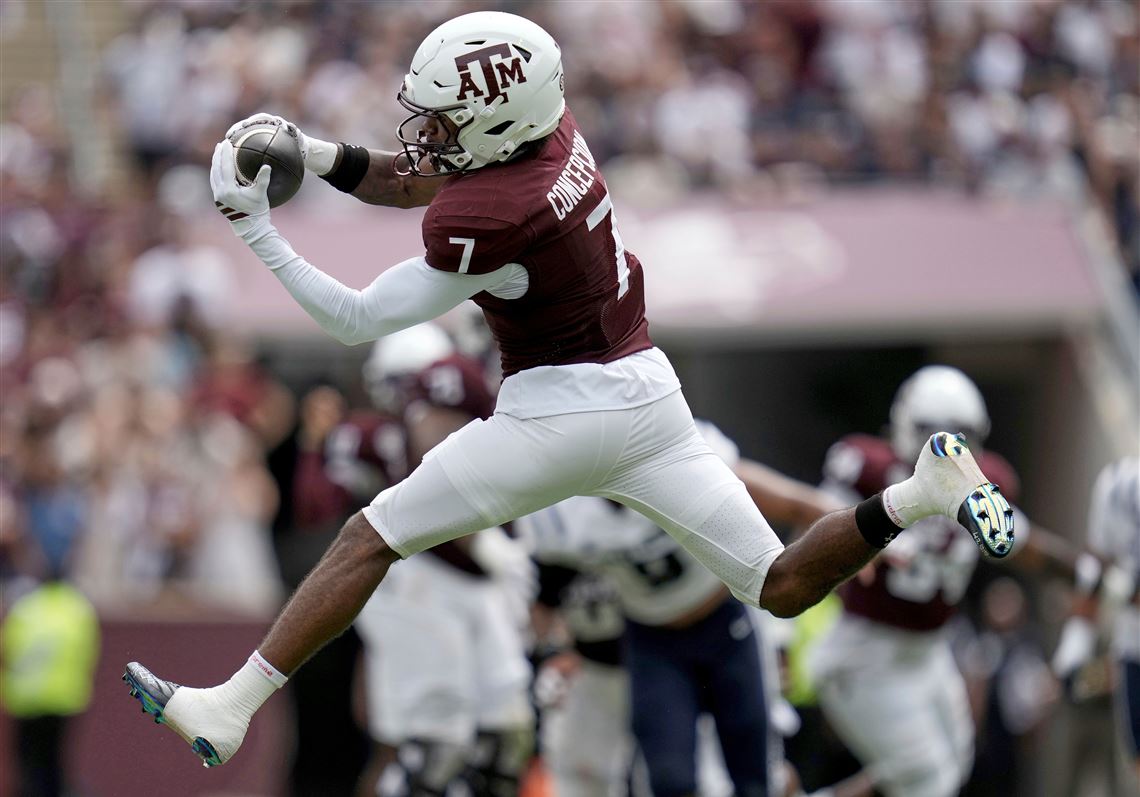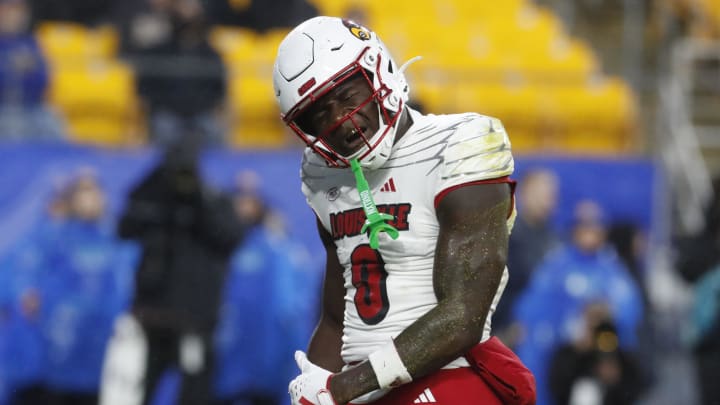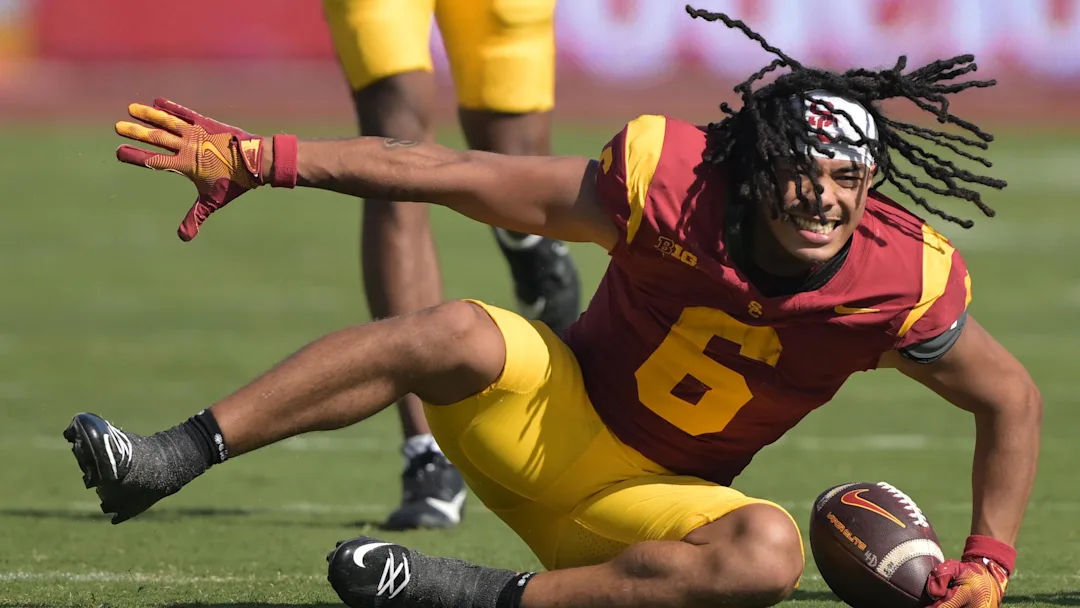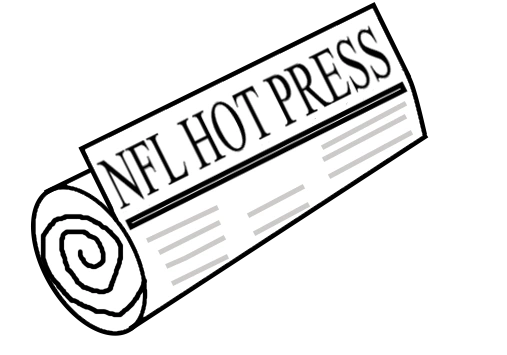By Charlie Campbell.
Send Charlie an e-mail here: [email protected]
Follow Charlie on Twitter @draftcampbell for updates.
This page was last updated March 9, 2020. Follow me @walterfootball for updates.
Quarterback Class
Early-round talent: A-
Mid-round: B
Late-round: C
Overall grade: B
Merging the 2020 and 2019 prospects
Joe Burrow
Tua Tagovailoa
Kyler Murray
Justin Herbert
Dwayne Haskins
Daniel Jones
Drew Lock
Jordan Love
Jacob Eason
Jake Fromm
Will Grier
Ryan Finley
Jalen Hurts
Just to be clear this article and series is all my opinion based off my own study and information I’ve gotten from general managers, directors of college scouting, national scouts, area scouts and NFL coaches who know way more than I do.
In my opinion, Joe Burrow and Tua Tagovailoa are better prospects entering the NFL than Kyler Murray was a year ago. I think Murray grades out ahead of Justin Herbert, but I think Herbert is about equal to Dwayne Haskins and Daniel Jones. I give a slight edge to Herbert, but those three are tied roughly in my eyes. I think Jordan Love, Jacob Eason, and Jake Fromm are not as good of prospects as Drew Lock was a year ago, but all three members of the Love-Eason-Fromm trio are better prospects than Will Grier was. Grier was a late third-round pick in the 2019 NFL Draft, and Love, Eason and Fromm should go higher than where Grier was selected. I would put Jalen Hurts as a third-day quarterback who is not as good of a prospect as Ryan Finley was last year.
Safest Pick: Joe Burrow, LSU

Previous Picks:
2019: Daniel Jones
2018: Sam Darnold
2017: Pat Mahomes
2016: Carson Wentz
2015: Jameis Winston
2014: Derek Carr
2013: Geno Smith
My track record here is pretty good. The 2013 class was a wash because there have been zero good quarterbacks to emerge from that year, so I’m not beating my chest that Geno Smith has managed to stick in the NFL as a backup. However at the time, I was smarter than the Buffalo brain trust that took E.J. Manuel with the 16th-overall pick of the 2013 NFL Draft. I’m proud I picked Derek Carr over Blake Bortles, Johnny Manziel and Teddy Bridgewater, who all wrongly went ahead of Carr in the 2014 NFL Draft. Derek Carr has turned into a quality starting quarterback, while the other three were disappointments for the teams that drafted them.
Jameis Winston is a decent starter, but is not as good as Tampa Bay expected him to be. Carson Wentz helped get Philadelphia a Super Bowl championship and is a franchise quarterback. Right now, Mahomes is best quarterback in the NFL, and he led his team to a Super Bowl Championship. Thus, I’m proud I picked Mahomes to be a safer pick than Mitch Trubisky and Deshaun Watson. Sam Darnold flashed in his first two years, and Daniel Jones did as well as a rookie. I think the New York kids are going to be good starters in the NFL.
This year, my choice was pretty easy as Burrow is, hands down, the safest of the quarterback prospects to turn into a quality starter. He is an accurate passer with good mobility, who makes excellent decisions, has quality size, and makes big plays in the clutch. Even if Burrow doesn’t turn into an elite starter, I think he has the floor of being respectable starting quarterback capable of leading his team to wins.
Biggest Bust Potential: Jordan Love, Utah State

Previous Picks
2019: Kyler Murray
2018: Mason Rudolph
2017: Mitch Trubisky
2016: Connor Cook
2015: Brett Hundley
2014: Johnny Manziel
2013: Mike Glennon
My track record here is pretty good. Obviously, it is too early to make a judgment on Murray, but his rookie year was a solid start to his career. Things are not looking as promising for Rudolph or Trubisky, as both are looking like they could fall short of being quality NFL starters, but they still have the time and opportunity to turn that around. Cook fell out of the NFL, but as a third-day pick, he was only expected to be a backup, so he really isn’t considered a bust unless he can’t hack it as a backup, and he’s probably headed to that status. Hundley is a backup, at best, in the NFL. I was right about Manziel being a bust. Glennon was a bust as a starter. At best, he is a backup.
Love looks like the riskiest of the early-round prospects for the 2020 NFL Draft. He has a good skill set with arm strength, mobility and upside. However, Love still has a lot to work on, with his field vision being painfully bad. He consistently locks his eyes on his primary read and does not move them away. He stares down targets and does not look off defenders. Love must start reading the field, working through his progressions, and making better decisions. Team sources felt that Love should have returned for his senior year to improve before going to the NFL, and given where he gets drafted, he could be forced onto the field quickly. I think Love has bust potential because the issues with field vision could lead to issues with interceptions and struggles to move the ball.
Quarterback Rankings by Attributes
Accuracy:
NFL prototype: Drew Brees, Saints
- Joe Burrow
- Tua Tagovailoa
- Justin Herbert
- Jake Fromm
- Jacob Eason
- Jordan Love
- Jalen Hurts
Recap: The most important characteristic for any quarterback in the NFL is accuracy. Not only do accurate quarterbacks reduce turnovers and maintain time of possession, they increase the opportunities for skill-position players to make a bigger impact. Thus, accurate signal-callers will give teams more return on their dollars with high-priced wide receivers. It takes an accurate quarterback to be a weapon as a pocket passer, and the elite quarterbacks are able to beat good coverage with precision passes into tight windows.
Burrow has an accurate arm and shows the ability to be a rhythm thrower. On top of being accurate on the short to intermediate throws, he can loft in touch passes downfield. His accuracy is also improved by his intelligence, as he knows where his receivers are going to be on any given play. That combination led to him being able to complete some passes in the face of the rush.
Tagovailoa is a steady passer who generally has good accuracy. He does well for the most part on his short and intermediate passes to hit receivers on the run on slants and crossing routes. Deep-ball accuracy is another strength for Tagovailoa, who can drop in passes downfield with precision.
When throwing from a clean pocket, Herbert can be deadly with his accuracy. He shows a nice ability to loft in touch passes and throw receivers open. He can drop in passes with nice ball placement that leads his receivers and beats quality coverage with the location of his passes. Herbert falls behind Burrow and Tagovailoa because they displayed more accuracy in the face of the pass rush and at throwing off platform.
Over the course of his collegiate career, Fromm was an accurate passer, but he had some regression in 2019. He has good ball placement to complete passes and keep the ball away from the defense. Fromm is very good in the short part of the field at throwing slants, digs, and crosses – the staple routes of a West Coast offense. With his timing and precision, Fromm has very good ball placement to help throw his receivers open. Fromm would be an excellent fit for a NFL West Coast offense.
Eason flashes the ability to be an accurate passer. He can fire precision fastballs into tight windows and beat good coverage with his ability to rifle the ball past defenders. Eason is accurate in the short to intermediate part of the field and throws some beautiful deep balls. Consistency is the issue with Eason, who can have stretches where his passes are off the mark and his ball placement is poor.
Team sources have highlighted that Love has issues with accuracy, which could be seen in his streakiness in 2019. He would make some incredible throws at times with beautifully located passes downfield throwing off platform. Then he had other passes that missed wildly. Improving his accuracy and consistency as a passer are critical for Love.
Hurts struggles with accuracy for the pro level. His college completion percentages weren’t outstanding, and they were inflated by tremendous receiver talent he was blessed with at Alabama and Oklahoma. Hurts can miss throws consistently and have passes far off the mark. His accuracy got better in his final season of college, but he still has a lot of room for improvement for the NFL.
Arm Strength:
NFL prototype: Pat Mahomes, Chiefs
- Jacob Eason
- Jordan Love
- Justin Herbert
- Tua Tagovailoa
- Jalen Hurts
- Joe Burrow
- Jake Fromm
Recap: The quarterback with the strongest arm doesn’t always mean that much, and that is given more validity with this group. Burrow will be the first quarterback drafted, but he does not have good arm strength for the next level, with arm just being average.
Eason, hands down, has the strongest arm in this draft class; he has a cannon. He stands out with the way the ball explodes out of his hand and the tightness of his spiral. Eason has an elite arm that can make all the throws required, possessing the ability to beat good coverage with the velocity of his passes. He instantly will be one of the stronger-armed quarterbacks in the NFL.
Love and Herbert have strong arms and can really spin the ball. That was clearly seen by area scouts, and then the rest of the league at the Senior Bowl. Herbert has the arm to make all the throws in the NFL. He can throw some fastballs into tight windows.
Tagovailoa does not have elite arm strength, but his arm looks good enough. Hurts’ arm is capable of competing in the NFL, but he does not have impressive arm strength.
Fromm’s arm strength is average at best, and scouts have told me the same thing. As a pro, he is going to struggle to challenge defenses downfield with his arm. Fromm also does not have the ability to fire a fastball into a tight window. Every throw from Fromm is a touch pass because he does’t have the arm strength to drive the ball.
Field Vision:
NFL prototype: Aaron Rodgers, Packers
- Joe Burrow
- Tua Tagovailoa
- Justin Herbert
- Jake Fromm
- Jacob Eason
- Jordan Love
- Jalen Hurts
Recap: Field vision is one characteristic that separates the elite quarterbacks of the NFL. Quarterbacks who throw a lot of interceptions are inclined to lock onto their primary reads and stare down receivers. Signal-callers with good field vision can quickly work through their progressions and see more than a receiver on a route. They also can help get wideouts open by looking off safeties and playing games with their eyes. Many college quarterbacks enter the NFL with subpar field vision and have to improve this at the next level.
Burrow and Tagovailoa are the best of this group, as they are skilled at reading defenses and working through their progressions to find the open receivers. Burrow was phenomenal in 2019 with his ability to see the field and to know where his receivers were going to be allowed him to work through his progressions quickly. Burrow also does a superb job of keeping his eyes downfield while on the run, allowing him to make some great throws while scrambling. The ability to see the field and read coverage is a massive strength, and it is rare to see a college quarterback this good at it entering the NFL. Tagovailoa has similarly good field vision, but is a notch below Burrow’s.
Herbert is able to read the defense and move his eyes off his primary read. In the face of a rush, Herbert stands tall and keeps his eyes downfield while the rush closes in on him. He shows advanced field vision to work through progressions and find the right receiver. With his size and pocket presence, Herbert stands tall in the pocket showing patience and doesn’t panic if his first read is covered.
Fromm has good field vision and executes well post-snap. He stands tall in the pocket with a calm and poised approach that leads to him showing field vision in the pocket, as he will move his eyes and work off his primary read. For a young quarterback, Fromm demonstrated impressive field vision from the very start of his time at Georgia.
Eason did show field vision on some plays, but there were times when he would lock onto his primary receiver and not work through his progressions quickly enough. Team sources say Eason struggles to process post-snap, and that can be seen in a variety of ways. He holds the ball too long as a result and must get faster at working through progressions. He has to get faster in the process of reading defenses, seeing his receivers, and getting the ball out. Those are the big issues for Eason, and if he doesn’t fix them, he’s going to struggle at the pro level. His inconsistency post-snap is one of the reasons why Fromm played over him at Georgia. With more playing experience, Eason’s field vision should improve.
Love’s field vision is bad and is a major area that he must improve upon in the NFL. Far too often, he consistently locked his eyes on his primary read and did not move them away. He would stare down targets and not look off defenders. Love must start reading the field, working through his progressions, and making better decisions. Part of the issues come from a lack of development in college and changing offenses that hurt Love’s development.
Hurts struggles to see the field, and throughout his time in college, he had a bad habit of looking to run if his first read was covered. That won’t work in the NFL, and Hurts has to get better at moving his eyes to work through progressions and read defenses.
Decision-Making:
NFL prototype: Tom Brady, Patriots
- Joe Burrow
- Jake Fromm
- Tua Tagovailoa
- Justin Herbert
- Jalen Hurts
- Jacob Eason
- Jordan Love
Recap: Burrow’s decision-making was off the charts in 2019. He did a great job of moving the ball and not putting passes in jeopardy of being picked, as his ball security is phenomenal. Despite a lot of attempts, Burrow had only six interceptions in 2019 and five picks in 2018. His decision-making was tremendous at LSU.
Fromm was very good with his decision-making over his collegiate career. Over his three seasons as a starter, he threw only 18 interceptions – six per year – and was very astute to protect the football.
Tagovailoa also was very good at decision-making over the past two seasons. It was very rare to see him throw a risky pass, and he was very reliable to avoid turnovers.
Hurts was steady at making safe decisions in college, but that will be challenged in the NFL, where he won’t be able to take off running like he did routinely at the college level.
Eason is a gunslinger-style quarterback who sometimes suffers from what I call, “big arm syndrome,” where he can have some flaws in his decision-making because he trusts his arm too much. That led to him throwing some passes he shouldn’t have into coverage. His decision-making also has some flaws from technique. While Eason is willing to use his feet, he is not as mobile as he thinks he is, and defenders would consistently chase him down, which led to him taking some unnecessary sacks. That will be exacerbated in the NFL given the faster defenders. Eason also has a tendency to drift backward because of his arm strength when he needs to be cognizant to climb the pocket. He makes his offensive tackles job more difficult when he does that because they can’t funnel rushers around the pocket due to this bad habit. Eason’s inconsistent decision-making post-snap was one reason he was benched for Fromm at Georgia.
Decision-making is going to be a point of improvement for Love, and team sources said issues with turnovers are something that concerned them about Love. That was given clear proof with the 17 interceptions Love threw in 2019. He must make better decisions to become a starter in the NFL.
Mobility:
NFL prototype: Lamar Jackson, Ravens
- Joe Burrow
- Justin Herbert
- Jordan Love
- Tua Tagovailoa
- Jalen Hurts
- Jacob Eason
- Jake Fromm
Recap: Mobility is important to help a team’s offensive line and wide receivers. As read options, spread offenses, and up-tempo concepts continue to grow in the NFL, mobility will continue to be a sought-after attribute for pro quarterbacks. The top-five quarterbacks in this group all have good mobility.
Of the top quarterback prospects for the 2020 NFL Draft, Burrow is deadly on the run. While Herbert, Love and Tagovailoa are more athletic and faster, Burrow has an uncanny ability to use his feet to produce big plays. He ran for 368 yards and five touchdowns in 2019 while making some huge, clutch plays with his feet. Burrow’s feet frustrated defenses, as he showed an ability to make something out of nothing.
Herbert is a quality athlete who has the ability to pick up yards on the ground. He won’t be a true running quarterback in the NFL like Michael Vick, Cam Newton or Deshaun Watson, but Herbert has the feet and agility to dodge pass-rushers and extend plays while also being able to pick up yards on the ground. Herbert runs faster than defenses expect and is faster than most quarterbacks. There are a few first downs per game that mobile quarterbacks are able to pick up, and Herbert will bring that ability to his pro team.
When plays break down, Love can use his feet to buy time, and he makes some good passes off platform. With his quickness and athleticism, Love is a threat to hurt defenses on the ground.
Tagovailoa is a good athlete with enough quickness to get yardage on the ground. His mobility and athleticism allow him to buy time and escape sacks. There were also times when Tagovailoa showed an ability to scramble and make throws off platform to move the chains.
Eason isn’t a bad athlete, but he is not as good of a runner as he thinks he is. Last year at Washington, he scrambled at times unnecessarily, and defenders didn’t have problems chasing him down. Fromm does not offer scrambling or running ability for the NFL.
Intangibles:
NFL prototype: Drew Brees, Saints
- Joe Burrow
- Jake Fromm
- Tua Tagovailoa
- Jordan Love
- Jacob Eason
- Justin Herbert
- Jalen Hurts
Recap: There isn’t a bad quarterback in the 2020 class in terms of intangibles. Of the quarterbacks, team sources have raved the most about the intangibles with Burrow and Fromm. Here’s how one team’s director of college scouting summarized Burrow, “Burrow is a gym rat, overcomer type with a severe chip on his shoulder having always been told he’s not quite good enough. He is possessed in his preparation, like a coach. [He’s] not an elite talent as a passer though.”
Multiple team sources have raved about Fromm’s intangibles. They say he is very smart, a great teammate, a hard worker, and coaches absolutely love him.
Tagovailoa is known to be a good kid with high marks for character. However, team sources also say that Tagovailoa will need to develop his preparation habits for the NFL.
Love is said to have good intangibles. Eason does not seem to invoke a strong reaction on intangibles.
Team sources say Herbert is a good kid off the field, but he is quiet and they have concerns about him not being a vocal leader. Some teams don’t care about a quarterback having that attribute, but others really want that. There are some teams that also question Herbert’s ability to lead his team to tough wins against good opponents and if he has a killer instinct to push his team to wins, like a Tom Brady or Russell Wilson. Some also question Herbert adjusting to life in the NFL after having lived in the same small town his entire life. Other team evaluators dismiss all of those concerns and point to some Pac-12 games in which Herbert led Oregon to victories and feel that he will be fine adjusting to NFL city life.
Publicly, Hurts has the reputation of having good intangibles. League sources, however, say Hurts is not the personality made out to be and they heard from some staff at Oklahoma who are happy to see Hurts leave the program. Behind the scenes, it sounds as though things weren’t as smooth for him in the transition from Alabama to Oklahoma.
NFL Picks - Dec. 28
2026 NFL Mock Draft - Dec. 24
NFL Power Rankings - Dec. 23
Fantasy Football Rankings - Sept. 1




